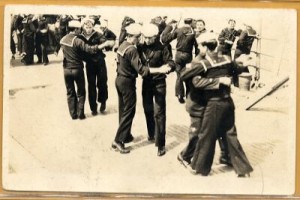Drag shows and the American military
 As the picture to my left shows, there is nothing new in the American military about men in what used to be an all-male, or predominantly-male, society still trying to resurrect a simulacrum of their civilian life. Two musicals that emerged during and immediately after World War II make heavy use of men in drag. The one with which most people are familiar is Roger and Hammerstein’s South Pacific, which revolved around sailors in the South Pacific during WWII.
As the picture to my left shows, there is nothing new in the American military about men in what used to be an all-male, or predominantly-male, society still trying to resurrect a simulacrum of their civilian life. Two musicals that emerged during and immediately after World War II make heavy use of men in drag. The one with which most people are familiar is Roger and Hammerstein’s South Pacific, which revolved around sailors in the South Pacific during WWII.
Most people remember South Pacific for two reasons: it’s principled stand against racism and the gooey hit song “Some Enchanted Evening.” I doubt many think of the scene in which Ray Walston dresses himself up in a coconut shell bra for the amusement of his fellow sailors and Marines (starting at 3:02):
Irving Berlin made even greater use of drag performances in “This Is The Army,” the Broadway-style review he created for the Army. It’s all-male, all-Army cast toured throughout the European theater in the thick of the war, bring a great deal of pleasure to the troops.
Because it was a Broadway-style review, Berlin of course had to write parts for women. And because there were no women to be had, every female part was a drag part. I can’t find any discrete clips but the entire movie is below, with the drag scenes at 58:00, 1:08, 1:12, and 1:28.
As best as I can tell, regardless of whether individual performers and audience members were getting a homoerotic thrill from the drag performance, the purpose behind these WWII shows was entirely heterosexual: it was to fill the gap the troops felt in their lives because of the women they left behind.
That was then. This is now:
KADENA AIR BASE, Okinawa — Since the repeal of the Don’t Ask, Don’t Tell policy, U.S. military bases have hosted a gay marriage ceremonies and a potluck gatherings. But on Saturday, servicemembers here may have been the first to take to the stage and perform as drag queens on a military installation in support of lesbian, gay, bisexual and transgender troops.
Drag queens and drag kings, to be precise.
Six servicemembers — gay, lesbian and straight — donned heavy makeup to dance and lip sync songs such as “I Wanna Dance with Somebody” for a raucous capacity crowd at the Rocker NCO Club at Kadena Air Base. The event was a fundraiser for the recently formed Okinawa chapter of OutServe-SLDN, which is the largest nonprofit advocate for the military’s LGBT community.
[snip]
But an initial 200 tickets were plucked up almost immediately, so they issued another 200.
“We ended up selling 400 tickets in 10 days,” she said.
Amid the unexpected success, OutServe carefully avoided any mention of politics, but its variety show comes at a pivotal time for gay civil rights in the United States, with many states passing laws dealing with marriage or debating individual liberties.
It is also a sign of the times within the military; just a few years ago, gay and lesbian drag performances on a military base would have been unthinkable and potentially a cause for dismissal from the service.
The repeals of Don’t Ask, Don’t Tell, as well as the Defense of Marriage Act — the law barring the federal government from recognizing same-sex marriages — have allowed gays and lesbians in the military to be open with their sexuality for the first time.
The historic shift appears to be mostly accepted and embraced throughout the ranks despite warnings the DADT repeal could harm order and good discipline.
On Saturday night, the Rocker club was packed for performances by servicemembers using stage names such as Chocolate Sunrise – a crowd favorite — and Artemis Faux. The event’s sole lesbian performer took the drag king name Manny Nuff.
I think Irving Berlin, Richard Rogers, and Oscar Hammerstein would be surprised.
I leave to your personal beliefs whether this is a change for the better or not, insofar as American military health is concerned. I just note that the military’s focus has changed a lot in the last seventy or so years.
